How to get rid of cellulite: 15 expert tips from dermatologists and nutritionists
Wondering how to get rid of cellulite? We're here to tell you that it's not impossible, thanks to these expert tips.
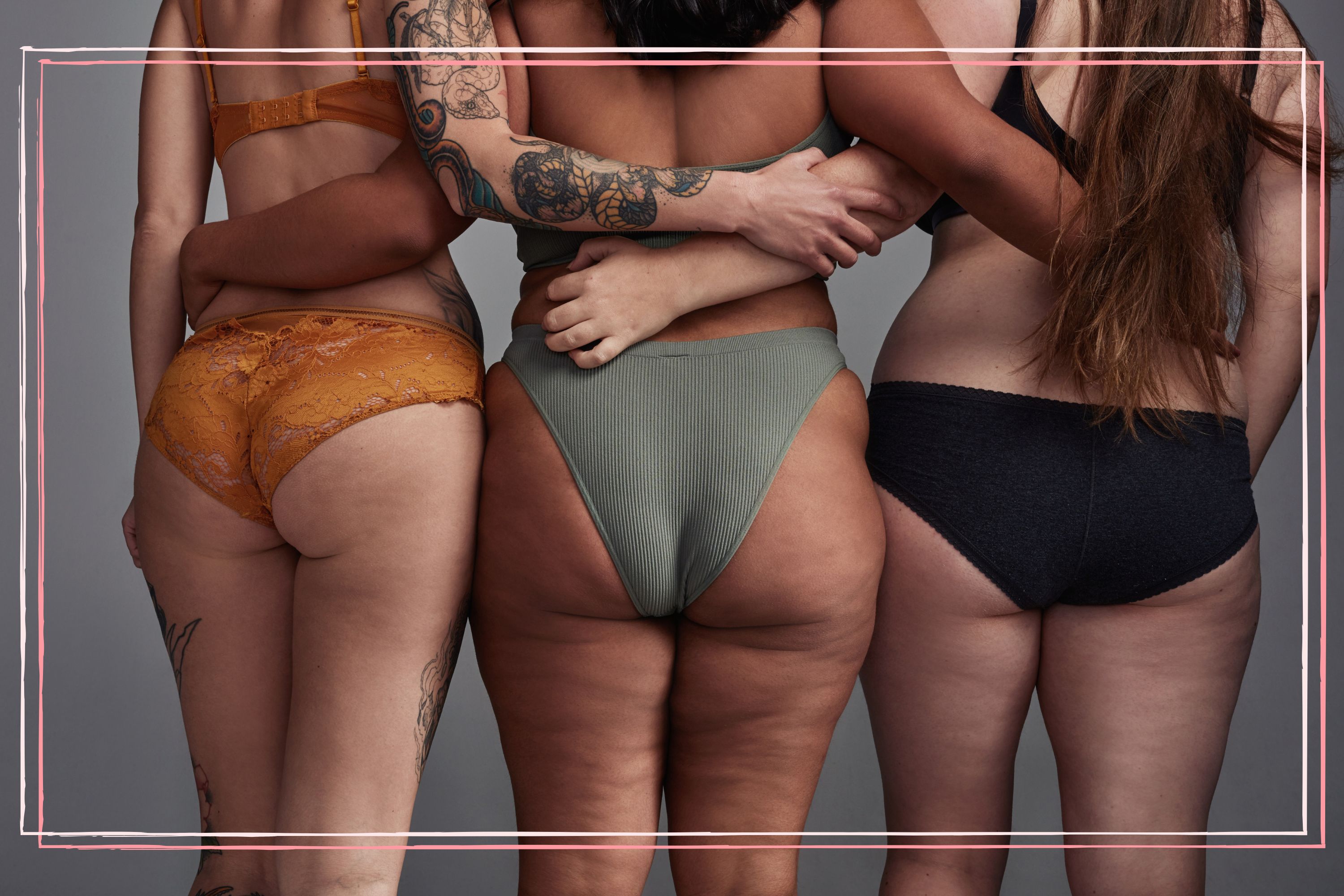

It's something that affects over 90% of women (and 10% of men), so it's no surprise many want to know how to get rid of cellulite. While you can't get rid of it completely, you can take steps to reduce its appearance.
Ahhh cellulite. Much like stretch marks, hard to get rid of spots and many other common body hang-ups, it can cause many of us some very unnecessary emotional stress. But while it might be undesirable for many, it's important to remember that cellulite is totally normal, and caused by the body's individual distribution of fat cells and connective tissue.
"Cellulite is the lumpy appearance of skin most commonly found on the thighs, stomach and bottom area," Dr Ross Perry tells us, Medical Director at Cosmedics skin clinics. "Fat pushes between the connective tissue beneath the skin, making the surface of the skin pucker and look lumpy. Most women have cellulite of some description or indeed will get it at some point in their lives and having it does not mean you are unhealthy. Cellulite is just natural imperfections in the way the fat is contoured in certain areas."
Most experts agree that there is no magic remedy that will get rid of cellulite for good, and in this new age of body acceptance, we're all for loving the skin we're in and feeling no pressure to change ourselves. This being said, healthier food choices, cardio and some simple skin practices that will benefit your overall physical health can help reduce the appearance of cellulite, should you feel the need to try them.
How to get rid of cellulite?
1. Body brush
Using a body brush - or 'dry brushing' as it's known - is a top tip to get rid of cellulite. According to celebrity facialist and skincare expert Lisa Harris, it's a type of Ayurvedic medicine that's been around for centuries. And it works in the same way as a lymphatic massage, promoting the release of unwanted toxins.
"Using a body brush increases circulation and exfoliates the skin, stimulates the lymphatic system and aids the body’s natural way of getting rid of toxins," she tells us. "Plus it's also believed to help break down fatty deposits under the skin that can result in cellulite."
For best results, Lisa recommends dry brushing a few times a week. But even once a week will show a difference in your skin texture.
"It’s best to do dry brushing with a natural brush with stiff bristles," she adds. "A long handle makes it easier to manoeuvre too and the best time to do it is before a shower or bath when the skin is dry – hence the name."
Whilst advice varies, Lisa recommends the common practice of brushing upwards towards the heart:
"Start at the hands and feet and brush towards the chest or torso," she explains. "But brush in a clockwise direction on the stomach area."
It's important not to do too many strokes in one area as it can make your skin sore, and never brush on skin that is infected, cut or grazed as this will not only hurt but "can spread the infection" too.
When you've finished brushing, follow up with a shower or bath. Then after drying up, apply a body oil to nourish your skin and you'll be feeling like you've had a proper pamper at the same time.
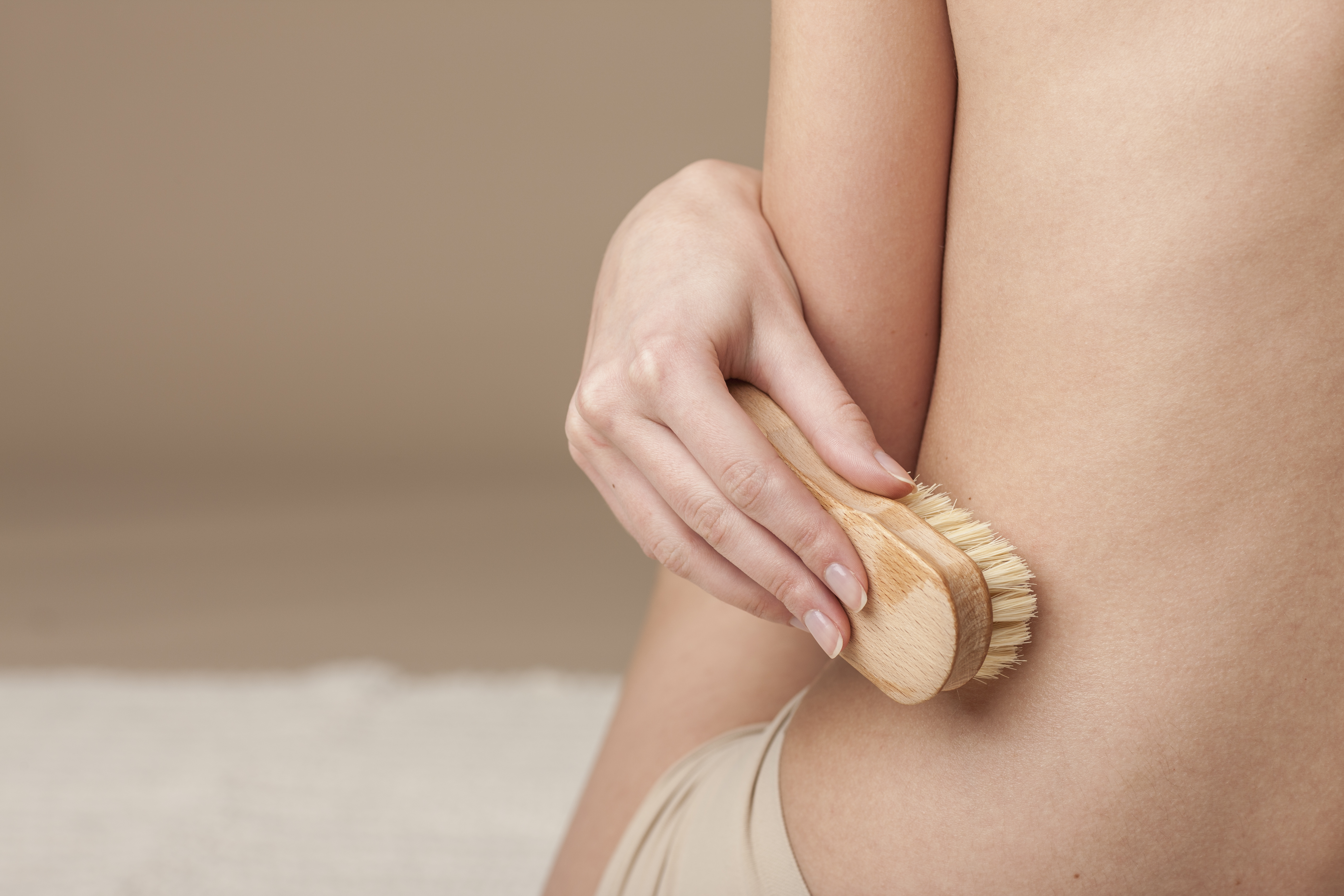
2. Lymphatic draining massage
"Lymphatic drainage for cellulite is a massage technique that works on the lymphatic vessels to remove swelling, oedemas, and cellulite," the Cellulite Institute told Goodto. They claim it not only enhances circulation but additionally "improves the appearance and tone of the skin as well as its temperature, and also causes relaxation of the muscle fibres."
Some scientific research has in fact shown this type of massage can work in our favour when it comes to getting rid of cellulite.
Participants in one 2011 Brazilian study published in the Clinical, Cosmetic and Investigational Dermatology journal received 10 sessions of "manual and mechanical lymph drainage", each lasting an hour and a half for two weeks. After the trial, all patients said they "liked the results". Plus examiners agreed that in before and after photos "the cellulite improved for 13 of the 14 patients".
Dr Anton Alexandroff, a Doctify-reviewed dermatologist agrees this technique can help with those thigh dumples, "Lymphatic draining massage is non-invasive, effective but time-consuming," he tells us.
Indeed, finding the time to massage for an hour and a half five times a week may be hard to commit to. But there certainly seems no harm in trying a five-minute at-home massage a few times weekly.
When performing at home, always massage from the bottom up and aim for loose and rhythmic movements. According to the Cellulite Institute, it's also good to apply a "slight pressure on the skin", before moving up and then releasing.
At-home lymphatic massage, step-by-step:
- Start at the top of your leg.
- Place one hand on the inside of your leg and one hand on the back of your leg.
- Gently stretch and release the skin from the inside of your leg towards the side of your leg and up towards your hip.
- Repeat movement five times on the targeted area.
- Shift your hands lower on your leg and repeat.
- Keep shifting down and repeating this step until you reach your knee as shown in the pictures.
3. Retinoid skin products
Dermatologist Dr. Anton Alexandroff says that retinoid products are usually recommended when trying to get rid of cellulite.
"Topical treatments include retinoids which can help collagen production and dermal thickness," he tells us. "They also promote lipolysis - fat conversion. And topicals work better in combination with massage."
Harvard Health also credits Retinoids with stimulating the production of new blood vessels in the skin, which in turn improves circulation and skin colour.
Dr Alexandroff recommends retinoid products by Clarins, Shiseido and Glytone. And this Clarins Extra-Firming Body Cream contains retinol and boasts good reviews. Use it to moisturise before bed, or even better, after a quick lymphatic draining massage to see visible results.
4. Collagen peptides
Collagen is your skin's best friend, so it makes sense to boost your collagen count to help with the appearance of cellulite.
As we age, our body produces less collagen, which one Michigan Medical School study found leads to us developing wrinkles and dry skin.
"Cellulite breaks collagen bands in your skin’s connective tissue and collagen works to strengthen the skin’s elasticity and repair damaged tissue," explains Dr. Ioannis Liakas, Medical Director at Vie Aesthetics. "Taking Collagen Shots like those from ProtoCol, help to boost your dermal metabolism, strengthen and repair damaged tissue while improving your skin’s elasticity."
Dermatologist Dr. Anton Alexandroff agrees: "Cellulite improved with collagen peptides intake after six months. But it works better in normal-weight women and less so in overweight women."
Rejuvenated is another brand that offers collagen shots. They recommend taking their shots daily for 12 weeks to see the full benefits. "These findings fit with results from clinical studies regarding our product," they explain.
5. Cellulite creams
Cellulite creams are widely available online and stores. But do they deliver results?
It's important to remember that creams will only really help the appearance of cellulite if combined with a healthy, balanced diet and exercise regime. They can help superficially in the looks department, but they're not miracle workers, so save your pennies and don't fork out expensive creams that promise to melt the fat away.
- Best budget cellulite cream: Nivea Q10 Plus Firming Cellulite Serum, £11.99 from Superdrug.
- Best mid-range cellulite cream: Weleda Birch Cellulite Oil, £19.20 from Amazon.
- Best rated high-end cellulite cream: Clarins High Definition Body Lift, £31.65 from AllBeauty.
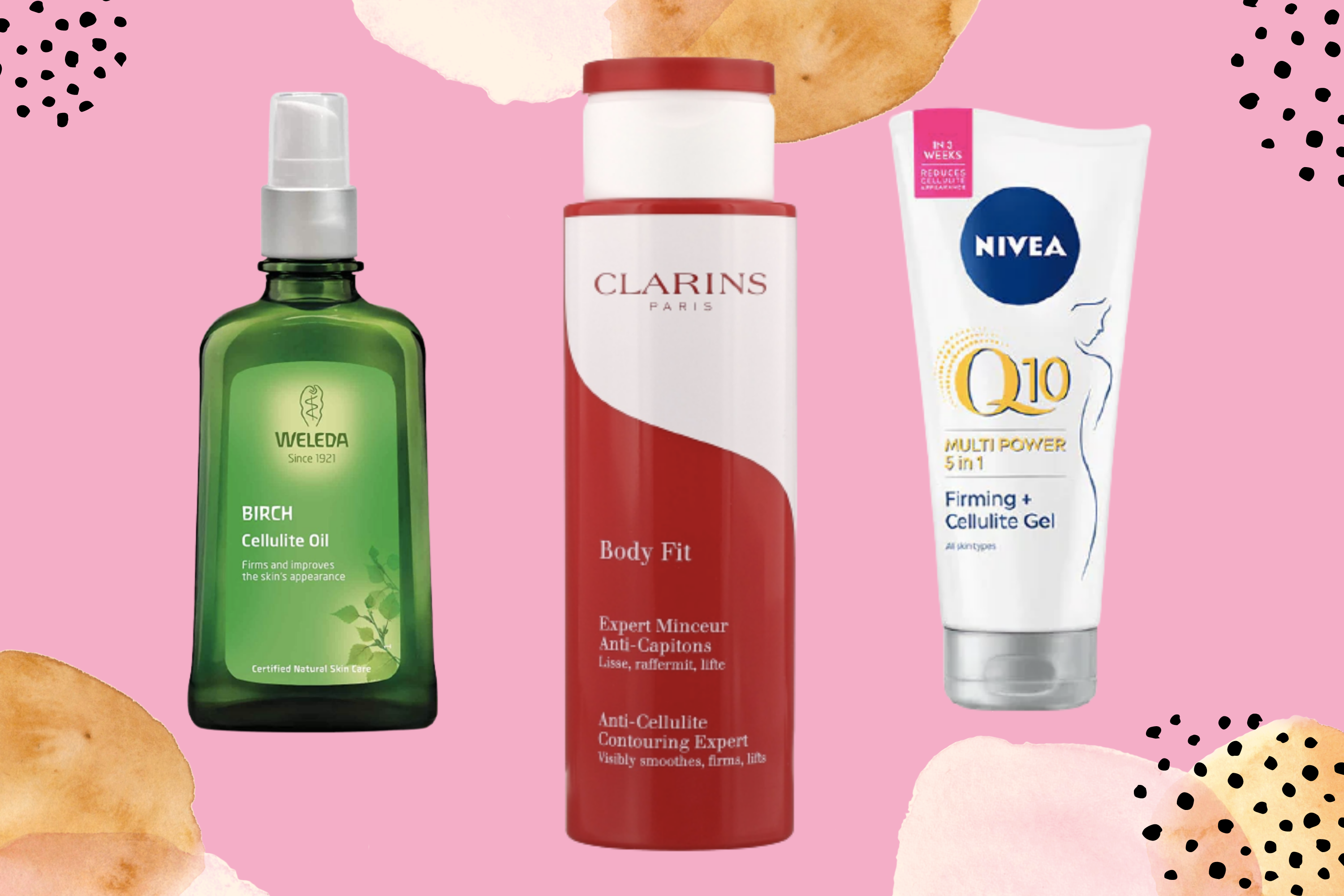
Credit: Future
Our top three chosen creams to get rid of cellulite have received praise for their smoothing abilities, and we've based our selection on online reviews, while taking different budgets into account, to help you choose the cream that suits you.
For better results, why not apply the cream after you've dry brushed and showered to help lock in the moisture.
6. Drink plenty of water
Keeping cellulite at bay is one of the many benefits of drinking water.
"Dehydration may make cellulite worse," explains wellness and nutrition expert Penny Weston. "This is because water flushes the toxins out of your body. However, if your body is lacking in water these toxins will be left to gather in certain places."
If you're wondering how much water to drink to keep skin looking fresh and youthful, follow the Eatwell Guide's government recommendation of six to eight cups or glasses a day.
This equates to around 1.5 litres a day which is plenty, as you don't want to drink too much water either - this could lead to swelling underneath the cellulite.
If you find plain water boring, flavour it naturally with slices of citrus fruit or berries. Or consider getting more H20 from your meals.
"One great way of staying hydrated is to eat more foods with a higher water content, such as fruits, vegetables and soups," says nutrition expert Linsey Doyle. "Not only are these foods great for keeping us hydrated but they're also packed with vital vitamins and nutrients that will repair cells and keep the skin looking fresher and more radiant.
7. Focus on HIIT workouts
Exercise is important when it comes to tackling cellulite. The premise is that the harder you work and the higher you get your heart rate, the more you'll burn fat, which in turn will help with the exterior appearance of said fat cells.
David Wiener, Training Specialist at fitness and coaching app Freeletics tells us that you want to "combine resistance or strength training with a HIIT workout" to see results.
"This is because strength training not only improves the tone of muscle tissue, but it also helps maintain and slowly increase the amount of lean muscle tissue in your body over time, which can help to create a smoother look," he explains.
"This combined with regular HIIT will help your body burn maximum calories in a short space of time. As well as keep your metabolism elevated for hours after exercise which is beneficial in the fight against cellulite."
Running is the most obvious choice for interval exercise. As are circuits, swimming and cycling, or any form of exercise which alternates intense periods of work, with short periods of rest.
Need help with where to start? There are plenty of great free fitness apps that provide a choice of tailored hit workouts.
- Freeletics Fitness: Apple, Google Play
- Nike Training Club: Apple, Google Play
- Workout Trainer: Apple, Google Play
- 7 Minute Workout: Apple, Google Play
8. Eat foods that provide lecithin
Lecithin is a substance that you might not be familiar with, but nutritionists swear by it when it comes to beating cellulite.
It's best explained as a substance that's made up of fatty acids and is naturally found in body tissue. And the reason it helps get rid of cellulite is that it repairs tissue cells in the skin, particularly preventing fat deposits rising to the surface.
"Eating foods that are high in Lecithin is also an excellent way to help manage cellulite," says nutrition expert Linsey Doyle. "Cauliflower, spinach and peanuts are all great sources of this powerful substance."
Lecithin rich foods:
- Eggs
- Apples
- Soy
- Peanuts
- Cabbage
- Broccoli
You can also take Lecithin tablets if that's more your style. Dr James Farthing, author of Beat Cellulite Forever suggests taking "1,200mg per day as a supplement, or buy it in health food stores and sprinkle it on cereal."
You can buy Lecithin tablets at health food shops such as Holland & Barrett.
9. Eat oily fish
As Linsey puts it: "If it swims it slims!". Oily fish helps the fight against cellulite by smoothing skin, improving circulation and encouraging the burning of fat cells.
"Mackerel, salmon, tuna, trout... all of these foods are excellent sources of Omega 3," she tells us. "These help enrich the skin - but are also super high in protein too. But cod-liver oil capsules are great options for those who don't eat fish."
Omega-3 fatty acids are known to lower cholesterol. This has a knock-on effect on cellulite, because by lowering your cholesterol you'll be boosting your circulation, which has an anti-inflammatory effect. This in turn prevents fat cells from swelling and appearing aesthetically worse.
Oily fish has also been proven to boost your metabolism and encourage it to burn fats, with one 2010 study published in the Journal of the International Society of Sports Nutrition finding that 6 weeks of fish oil supplements "increased lean mass and decreased fat mass".
An easy way to remember your oily fish is the acronym SMASH - salmon, mackerel, anchovies, sardines, and herring. All these fish varieties contain around 30% oil in their skin - hence the name.
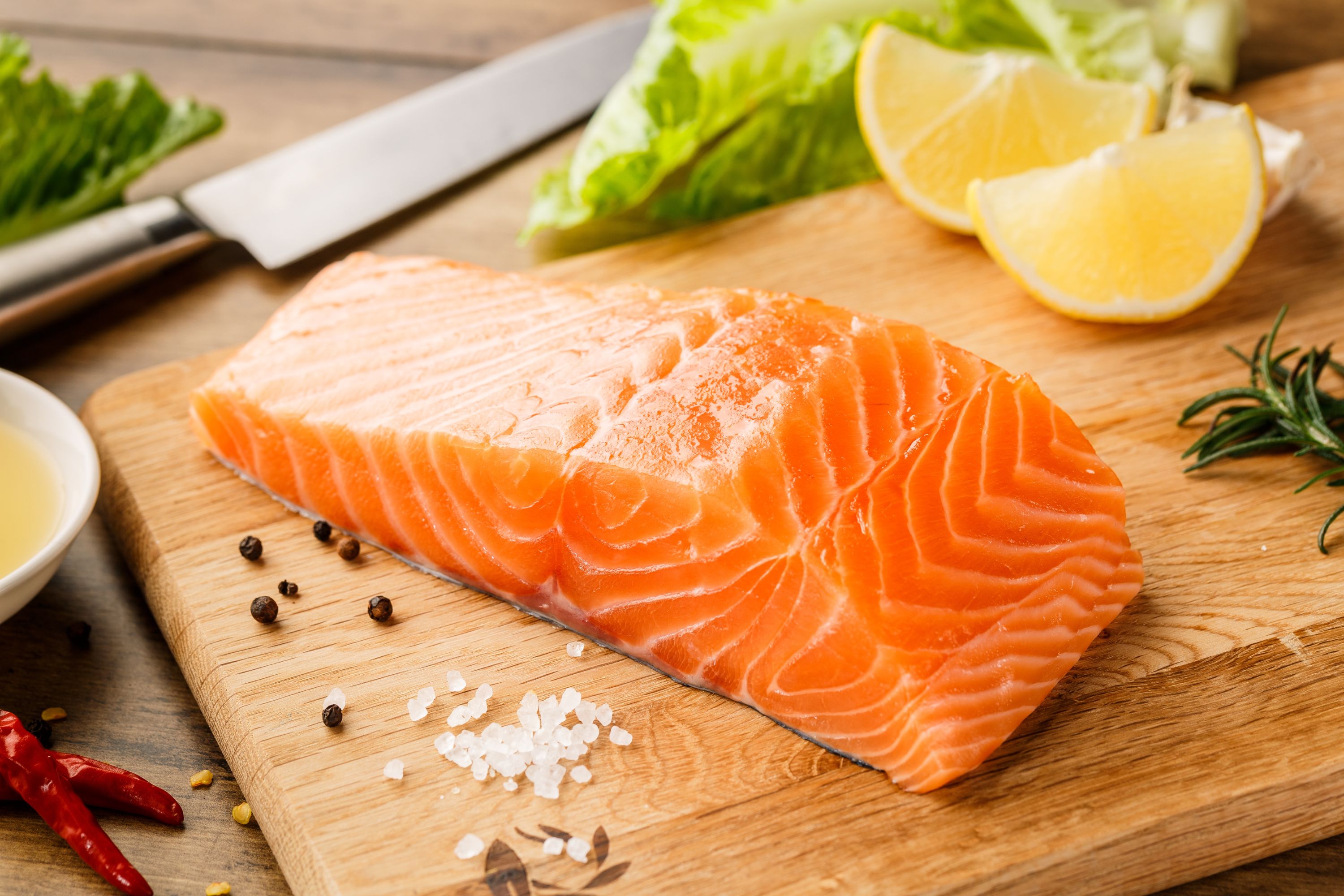
10. Take the stairs
It can be as simple as switching the lift for stairs when combating cellulite because this activity will raise your heart rate whilst targeting your lower body muscles.
"Stair climbing is particularly effective because it is a form of cardiovascular exercise with the added benefit of targeting your lower body," says training specialist David Weiner. "Therefore working all the main muscle groups in the area where cellulite tends to accumulate."
This short but simple will exercise will put pressure on underlying fat stores and replace lost muscle tissue to give the area a toned appearance. Indeed, British actress Liz Hurley swears by always taking the stairs to keep off the pounds and to get rid of cellulite as it stimulates circulation and keeps your skin dimple-free. So if it's good enough for her...
11. Up your protein intake
"Getting enough protein is key when it comes to providing the cells in our body with all the tools they need to grow, repair and thrive," says nutrition expert Linsey Doyle.
Put simply, high-protein food stimulates and strengthens the production of collagen and elastin, which keeps cellulite at bay. It also helps to firm up muscles that can keep fat stores in place, and reduces the dimpled effect of cellulite.
Science confirms this as one Japanese study found that it's the amino acids in proteins that help develop collagen, which in turn helps maintain healthy skin and banish cellulite.
High-protein foods:
- Lean meats
- Turkey
- Fish and seafood
- Eggs
- Nuts
- Chickpeas
- Kidney beans
- Skimmed milk
- Greek yogurt
- Cottage cheese
12. Avoid fast food and salty meals
We know that junk food does little for our waistlines, but it can contribute to cellulite on our legs too by building up the fat cells in our body and causing inflammation.
"Eating processed foods and foods that are high in sugar and salt can lead to an accumulation of toxins and fat in the body," explains fitness and nutrition coach Penny Weston, founder of health club WelcometoMade. "So it makes sense that reducing your intake of these will help to reduce the appearance and texture of cellulite."
Swelling is another common side effect after eating a greasy takeaway, with researchers of one Harvard Medical study reporting that high salt in your diet "promotes tissue inflammation". It's no wonder then that cellulite appears worse after a big fast food blow-out.
Take extra care to only treat yourself to fast food now and again, or similarly have a go at making your own healthy homemade takeaways to get the same flavour with less of the salt, sugar and fat.
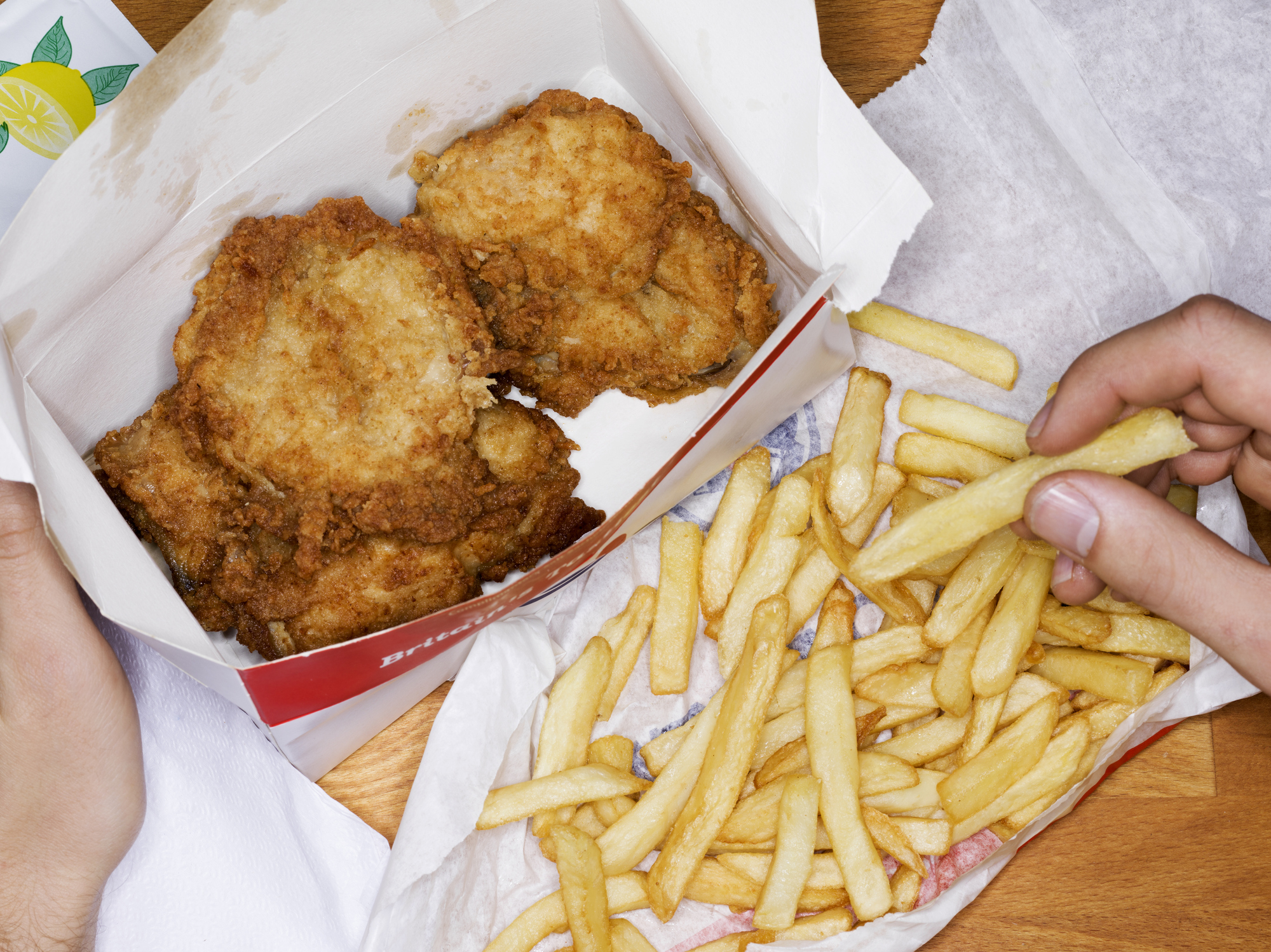
13. Get your five a day
Cellulite is caused by a build-up of toxins, so fruit and veg high in antioxidants are the best way to beat lumpy skin from the inside out - though certain types of your five a day will prove more beneficial against dimpling than others.
Green vegetables like broccoli, runner beans and kale are best, as these are packed with fibre, antioxidants and enzymes that reportedly have a cleansing effect on the bowel and remove toxins. Go one step further and eat them raw if you can - as uncooked veggies contain more nutrients.
Brightly coloured fruit and vegetables are also amongst the best to help get rid of cellulite. Try celery, oranges, grapefruit, peaches and plums, as they’re low in natural sugar and high in fibre. These citrus fruits are also high in vitamin C which is additionally great for cellulite. One 2018 study published in the Orthopaedic Journal of Sports Medicine found that this particular vitamin boosts the production of type one collagen in the skin, which is essential for promoting elasticity and keeping skin firm and taut.
14. Pop a supplement
Sometimes it simpler to combine our diet with a few multivitamin tablets to ensure we're getting the good stuff into our bodies. And Sonia Khan, a Senior Pharmacist at Medicine Direct, says vitamin E, B6, calcium and fish oils are cellulite-busters.
"Vitamin E can help with blood circulation and B6 helps to reduce fluid formation in the skin, which may reduce the appearance of cellulite," she says. "Calcium also reduces fat in the body, which can reduce the appearance of cellulite too."
It's those omega-3 fatty acids again that are found in fish oil which makes it a great match for cellulite. It works to lower cholesterol and blood pressure which in turn keeps your skin's cells healthy and at less risk of cellulite.
"However, I would point out that taking supplements will not rid the body of cellulite completely," adds Sonia. "As with any medicine, you should always talk to your doctor or pharmacist before you start to take a course of supplements for any reason. Especially for a reason that is more cosmetic than medical like cellulite."
15. Non-surgical aesthethic treatments
- Cryolipolysis: "This claims to freeze and kills fat cells improving the appearance of cellulite," says cosmedic doctor Ross Perry. It's ultimately used for body shaping, flushing the destroyed cells away during digestion. But the fat removal of this procedure means it can improve cellulite too. "It can take three treatments and 3 or 4 months for you to see results," he adds.
- BodyTite: Dr Ioannis Liakas, Medical Director at Vie Aesthetics explains the science behind this cellulite treatment. "It works by using RadioFrequency to heat and liquefy fat tissue for removal, while stimulating collagen production to strengthen the skin." Prices start from £4,000 at his London clinic.
- SlimDrone: Red LED lights help rejuvenate the skin, whilst thermo and electro stimulation work to encourage fat cell burning and the toning of muscles in this treatment. "It promises to improve muscle tone, streamline and improve skin texture, reduce cellulite, target loose skin and, uniquely, treat water retention and bloating," explains celebrity facialist Lisa Harris, who's clinic offers it.
- Mesotherapy: This involves a cocktail of nutrients including Amino Acids and Hyaluronic Acid being injected directly into the cellulite. "The injections prevent the body from storing fat by improving the local metabolic rate," explains Dr Ioannis Liakas. "This treatment is incredibly effective for reducing cellulite because of its precise application."
- Morpheus8: This uses RadioFrequency to melt away fat and then finishes by Microneedling to further stimulate collagen production, tone, strengthen and firm the skin.
We've rounded up the latest non-surgical treatments that are offered to help get rid of cellulite. These tend to cost a couple of thousand pounds, so might not be an option for some, but if you feel strongly about getting rid of cellulite and natural remedies aren't helping, then they might be something to consider.
It's also important to remember though that no-one should feel forced or pressured into a clinical treatment. Those outlined above are carried out by qualified professionals with extensive expertise, but always be sure to do your research (of the clinic and treatment) before committing.
How long does it take to get rid of cellulite?
There's no clear cut, universal answer on how long it takes to get rid of cellulite. And it's important to remember that it will never disappear completely - but it's appearance may improve with extra care and attention.
"It is difficult to put a timespan on cellulite reduction because everybody is different," says Dr Ioannis Liakas. "Its lifetime can also depend on the severity of the cellulite and type of product or procedure used for treatment.
Pharmacist Sonia Khan shares that there is little scientific research which outlines how long it takes to reduce cellulite. But any treatment or at-home effort to tackle it should be given three weeks to see if "any noticeable improvements take place.”
"Scientific research has also suggested that none of the cellulite treatments on the market actually work to permanently reduce the appearance of this problem, although some can provide longer lasting results than others," she adds.
What causes cellulite?
Cellulite is something that continues to baffle the experts. But it's thought to be caused by a build up of fat cells (wedged between muscle) which push underneath the skin's tissue.
"This creates an uneven skin surface and makes the skin look wrinkled, dimpled or lumpy," explains pharmacist Sonia Khan.
Why this happens is unclear. But Dr Ioannis Liakas highlights genetics, age, lifestyle and body fat percentage as factors that contribute to cellulite developing.
"Cellulite can be caused by pregnancy, a poor diet, unhealthy lifestyle and sudden weight gain," he tells us. "It is graded on its severity from 1-3, with 1 being a mild dimple-like appearance to 3 being more severe with visibly significant indentations."
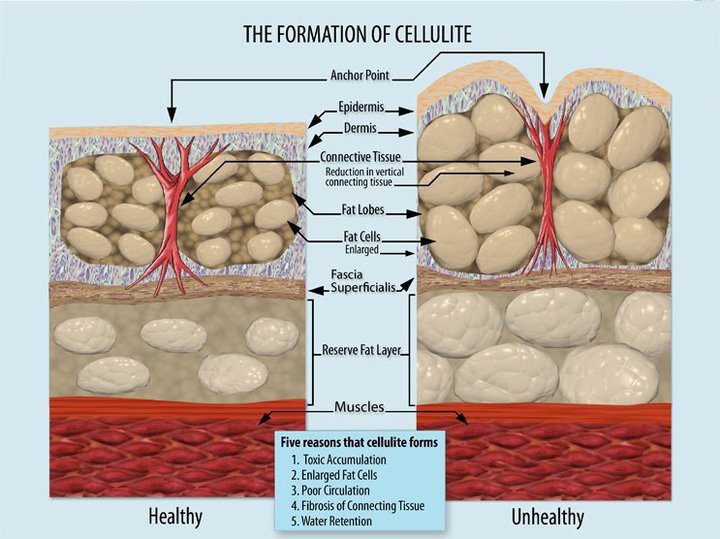
Can losing weight reduce cellulite?
In short, whilst losing weight will indeed decrease fat levels, it won't get rid of cellulite. This is because cellulite is a skin-based condition that's linked to the aging process. And as we age we lose elasticity in our skin, which leads to more cellulite developing.
As Dr Ross Perry explains: "Cellulite is of course more prominent in those carrying excess weight. This can exacerbate the appearance of cellulite, as weight gain increases the volume of fat in the area. However, cellulite can be also found in young, fit, slim women. So is not an indicator of health or fitness and can quite often be down to genetics."
Dr Ioannis Liakas agrees that even the most active among us are still susceptible to cellulite. "In fact, many personal trainers have reported that they too have cellulite as a result of genetics," he tells us.
This being said, Dr Liakas believes that "a healthy diet and exercise can certainly help to build and strengthen muscle, and reduce body fat which, in turn, will improve areas that cellulite is visible."
If you're looking for more expert-approved beauty advice, we've also asked how to get rid of neck wrinkles, dark circles and acne scars, as well as how to use a jade roller on your face and top tips for soothing a dry scalp.
We spoke to the following experts:

Ross qualified at Guy’s & St Thomas’ Hospital Medical School in 1994 and pursued a surgical career that now comprises NHS skin cancer reconstruction and private cosmetic skin treatments.
He is the Medical Director of Cosmedics Skin Clinics, which he established in 2003.

With over 25 years in the skincare industry, Lisa Harris and her team know exactly what it takes to help you look & feel your best. Combining knowledge and experience Lisa offers natural, results-driven treatments, to help you achieve healthy, flawless looking skin without the use of botox or fillers.

Consultant Dermatologist at Harley St offices, Cambridge Nuffield Health hospital, Cambridge Spire Lea hospital, Leicester Nuffield Health hospital, and Bedford BMI Manor hospital, Anton began his research career with a PhD at Edinburgh University in the field of cancer Immunology and has since published over 40 peer-reviewed research papers and reviews. Clinically trained in the United Kingdom, he has worked at major NHS teaching and private hospitals in Cambridge, Newcastle, Nottingham, Leicester and London.

Dr Ioannis Liakas has decades of experience as an NHS Consultant of Internal Medicine and Gerontologist, and he has been an experienced practitioner in Aesthetic Medicine for over 12 years. Dr Liakas is a Fellow of the Royal College of Physicians (FRCP), Honorary Senior Lecturer at Queen Mary Medical School, and a Member of the British College of Aesthetic Medicine.
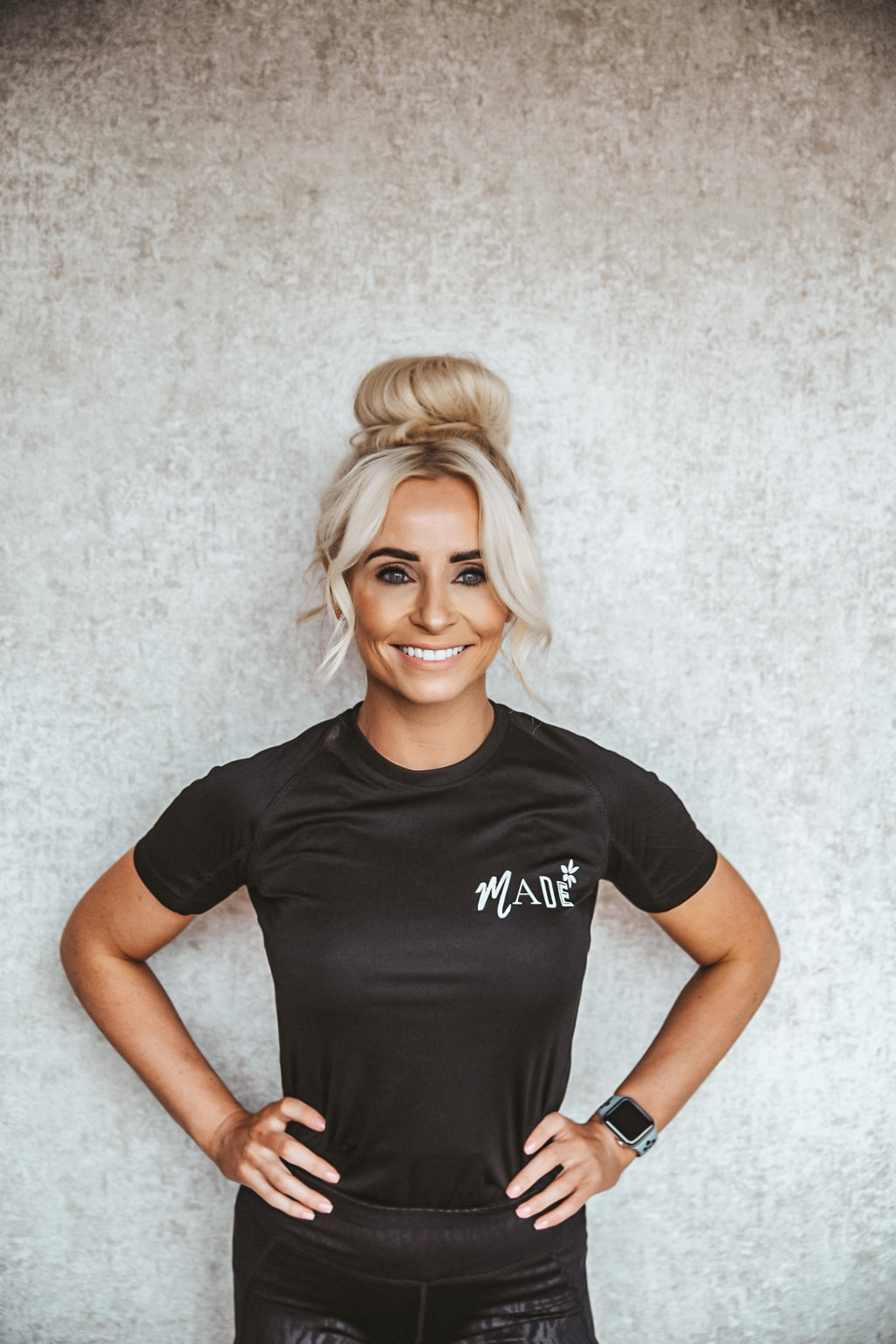
Penny is a fitness, wellness and nutrition expert, and the director of Moddershall Oaks Country Spa Retreat and founder of MADE, a 360 degree wellness centre. She is accredited by the Royal Society for Public Health (RSPH) and certified by the Association for Nutrition (AfN).

David Wiener is a Freeletics Training and Nutrition specialist and a level 3 personal trainer with a huge passion for health and fitness. David works closely with his clients to motivate and inspire them to reach their goals both in one to one and group sessions. He believes that health and fitness should be a massive part of people’s lives, and he loves working with his clients to improve their physical and mental wellbeing, pushing them to their maximum.
GoodtoKnow Newsletter
Parenting advice, hot topics, best buys and family finance tips delivered straight to your inbox.

Emily Stedman is the former Features Editor for GoodTo covering all things TV, entertainment, royal, lifestyle, health and wellbeing. Boasting an encyclopaedic knowledge on all things TV, celebrity and royals, career highlights include working at HELLO! Magazine and as a royal researcher to Diana biographer Andrew Morton on his book Meghan: A Hollywood Princess. In her spare time, Emily can be found eating her way around London, swimming at her local Lido or curled up on the sofa binging the next best Netflix show.